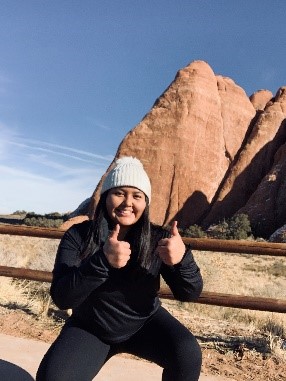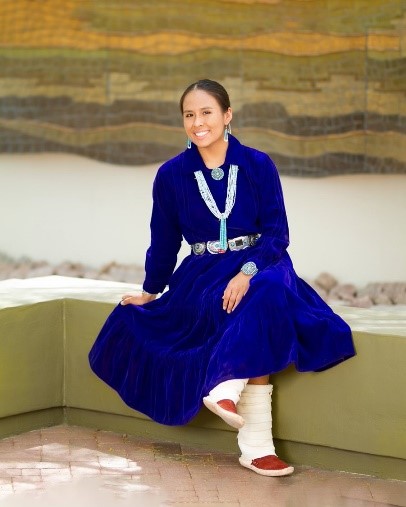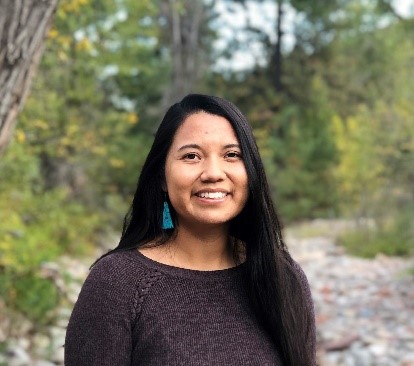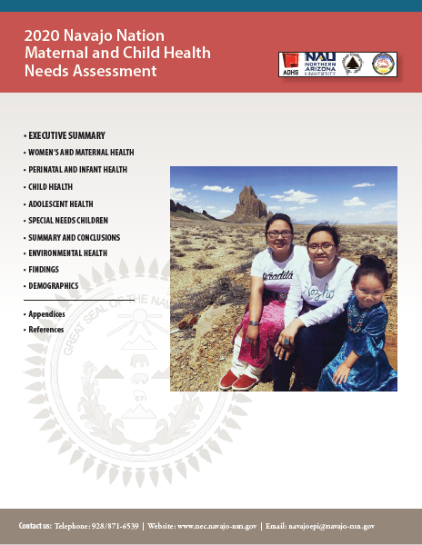Navajo students are contributing to public health efforts in diabetes, COVID-19, domestic violence, and maternal and child health through the Navajo Native American Research Center for Health (NARCH) Partnership. “Our goal is to really enhance the educational pathways available to Navajo students from high school to graduate school and beyond,” says Mark Bauer, Ph.D., a co-director of the Navajo NARCH Partnership and professor at Diné College—a tribal college on the Navajo Nation. (Diné means “the people” and is how Navajo people refer to themselves in their native language.)
An Introduction to Public Health Emphasizing Navajo Perspectives

Through the Navajo NARCH Partnership, high school students can participate in a range of opportunities including a 1-week Indigenous Summer Enhancement Program (ISEP), internships, and a dual-enrollment program where they can earn a certificate in public health from Diné College while in high school. Mikenzie John took part in all three of these.
Mikenzie says that ISEP, which she participated in during 2019, was a great introduction to the basics of public health and taught her about Navajo leaders in the field. During the program, she heard about the dual-enrollment opportunity and took her first course at Diné College just a few months later. The public health course on nutrition stood out to Mikenzie the most. “The class incorporated both Western and Indigenous nutrition, so I got to see the differences between the two and how they affect the body,” she says.
In 2020, Mikenzie returned to ISEP as a peer mentor. She also interned with the Tribal Turning Point research study, supporting its efforts to educate children at risk for diabetes about a healthy lifestyle. “People in my area, especially high school students, don’t really get internships,” she says. “And I thought that was a great opportunity to jump on and get more experience.” She graduated in May 2021 and plans to attend Fort Lewis College and major in public health.

Lauren Etsitty is another student who participated in ISEP, and she says that the program helped her decide to pursue a public health career. In the fall of 2020, she interned with the Diné Policy Institute, summarizing Navajo Nation legislation about pandemic protocols and transcribing interviews with Navajo community members.
Lauren then interned with the Johns Hopkins Center for American Indian Health in the spring of 2021. She gathered publicly available data about COVID-19 in tribes; the data was then sent to the applied physics team at Johns Hopkins University and displayed on the university’s COVID-19 dashboard. “Working with the applied physics team was my favorite part of the internship because, personally, I’m interested in how physics and engineering tackle public health issues, such as providing information during a pandemic,” says Lauren. She graduated in May 2021 and is pursuing her bachelor’s degree in mechanical engineering at Lehigh University.
Hands-On Research Experience

For undergraduate students, the Navajo NARCH Partnership offers research training and experience through a 10-week Summer Research Enhancement Program (SREP). “It was really meaningful to see people like me with similar experiences doing the work that they’re doing and then giving back and teaching younger versions of themselves,” says Taylor Billey, who participated in the program in 2019.
SREP starts with 3 weeks of classes on public health study designs and methodologies. Then, students are placed at various internship sites for 6 weeks. Afterward, they have a week to prepare a presentation about their experiences. Taylor worked with the Domestic Violence Prevention Initiative in Shiprock, New Mexico. She collected data about the resources available to victims of sexual assault or domestic violence and interviewed community members about these topics.
Taylor says the hands-on experience helped prepare her for her current job as a research program assistant with the Johns Hopkins Center for American Indian Health. She works primarily on Family Spirit Nurture, a program that supports mothers and their children to help prevent early childhood obesity. She’s also taking classes toward a master’s degree in public health.
Mentorship and a Landmark Report
Northern Arizona University leads the Navajo NARCH Partnership alongside Diné College, and students pursuing master’s degrees in public health there can choose a concentration in Indigenous health, thanks to the partnership. The Indigenous health concentration highlights American Indian perspectives on health and unique considerations for working with Indigenous communities.
“I really appreciated meeting these public health professionals who were Native American and who mentored me,” says Kristen Tallis, a graduate of the master’s program who completed the Indigenous health concentration. “It made it easier to get through the courses and perform in the classroom, and now they’re still part of my circle.” (Photo not available)

Students in the master’s program are required to complete an internship. For hers, Kristen helped collect data on maternal and child health in the Navajo Nation that ultimately became part of a landmark report that was published in 2020. Other graduate and undergraduate students who participated in NARCH programs also contributed to the report, which was produced in collaboration with the Navajo Epidemiology Center and supported by the state health department of Arizona.
“It’s now one of the featured reports on the Navajo Epidemiology Center website, and the state of Arizona is even saying, ‘Gosh, you helped put us on the map as far as a state that’s doing a good job of trying to represent the Indigenous part of their population,’” says Dr. Bauer. “I would like to see us do more things of that sort so that all of the students we’ve been working with at all of these different levels can see that they’re part of something bigger.”
The Navajo NARCH Partnership is supported by NIGMS grant S06GM123550.

